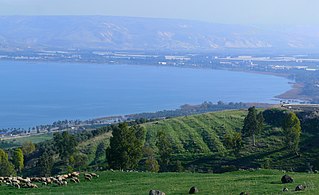
The Dead Sea, also known by other names, is a salt lake bordered by Jordan to the east and Palestine's West Bank and Israel to the west. It lies in the Jordan Rift Valley, and its main tributary is the Jordan River.

The Red Sea is a seawater inlet of the Indian Ocean, lying between Africa and Asia. Its connection to the ocean is in the south, through the Bab el Mandeb strait and the Gulf of Aden. To its north lie the Sinai Peninsula, the Gulf of Aqaba, and the Gulf of Suez. It is underlain by the Red Sea Rift, which is part of the Great Rift Valley.

The Sea of Galilee, also called Lake Tiberias or Kinneret, is a freshwater lake in Israel. It is the lowest freshwater lake on Earth and the second-lowest lake in the world, at levels between 215 metres (705 ft) and 209 metres (686 ft) below sea level. It is approximately 53 km (33 mi) in circumference, about 21 km (13 mi) long, and 13 km (8.1 mi) wide. Its area is 166.7 km2 (64.4 sq mi) at its fullest, and its maximum depth is approximately 43 metres (141 ft). The lake is fed partly by underground springs, but its main source is the Jordan River, which flows through it from north to south and exits the lake at the Degania Dam.

The Gulf of Aqaba or Gulf of Eilat is a large gulf at the northern tip of the Red Sea, east of the Sinai Peninsula and west of the Arabian Peninsula. Its coastline is divided among four countries: Egypt, Israel, Jordan, and Saudi Arabia.

The dottybacks are a family, Pseudochromidae, of fishes which were formerly classified in the order Perciformes, but this has been revised and the family is regarded as of uncertain affinities, or incertae sedis within the Ovalentaria, a clade within the Percomorpha. Around 152 species belong to this family.

The Lessepsian migration is the migration of marine species across the Suez Canal, usually from the Red Sea to the Mediterranean Sea, and more rarely in the opposite direction. When the canal was completed in 1869, fish, crustaceans, mollusks, and other marine animals and plants were exposed to an artificial passage between the two naturally separate bodies of water, and cross-contamination was made possible between formerly isolated ecosystems. The phenomenon is still occurring today. It is named after Ferdinand de Lesseps, the French diplomat in charge of the canal's construction.

Fishing in Israel is a branch of the Israeli economy with historical significance. The three main natural fishing zones are the Mediterranean Sea, the Gulf of Aqaba, and the Kinneret. A fourth area that was once historically significant, Lake Hula, no longer exists, as it was drained in the 1950s. In addition, aquaculture the growth of fish in ponds or in cages, is rising in prominence.
Chlidichthys inornatus is a species of fish in the family Pseudochromidae.
Chlidichthys is a genus of ray-finned fishes from the western and central Indian Ocean, it is part of the subfamily Pseudoplesiopinae which in turn is a constituent subfamily of the dottyback family, the Pseudochromidae. Within the Pseudoplesiopinae, Chlidichthys is regarded as a sister taxon to Pectinochromis.
Chlidichthys abruptus, or St Brandon's dottyback, is a species of fish in the family Pseudochromidae.
Chlidichthys auratus, the golden dottyback, is a species of fish in the family Pseudochromidae.
Chlidichthys randalli is a species of fish in the family Pseudochromidae.
Chlidichthys bibulus, the nosey dottyback, is a species of fish in the family Pseudochromidae.
Chlidichthys pembae is a species of fish in the family Pseudochromidae.
Chlidichthys johnvoelckeri, the cerise dottyback, is a species of fish in the family Pseudochromidae.
Chlidichthys cacatuoides, the cockatoo dottyback, is a species of fish in the family Pseudochromidae.
Chlidichthys chagosensis, the Chagos dottyback, is a species of fish in the family Pseudochromidae.
Chlidichthys clibanarius, the chainmail dottyback, is a species of fish in the family Pseudochromidae.
Chlidichthys foudioides, the Fody dottyback, is a species of fish in the family Pseudochromidae.






